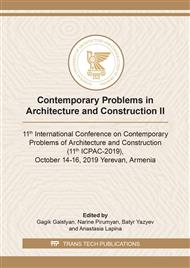p.1
p.9
p.14
p.18
p.24
p.31
p.40
p.53
p.58
The Use of Lightweight Concrete Effectiveness in Volcanic Resistant Construction
Abstract:
The article is devoted to the topical problem - to increase seismic resistance of erected buildings in the Republic of Armenia. Armenia is rich in volcanic rocks of glassy structure, which possess sufficient excess free energy of particles of matter and this energy can be regarded as a work stock that they can accomplish, i.e. can be regarded as kinetic energy. One of the most active rocks in the republic is the lithoid pumice of the Jrauber-Lusavan deposit, a spongy material of an acidic composition, the amorphous phase of which reaches up to 98%. We studied this rock for obtaining lightweight structural concrete using energy-saving technology. The amorphous structure of pumice gives the possibility of expensive Portland cement to be replaced in part by a cheaper bonded binder - a fine-grained mixture of quicklime and aluminosilicate rock. Due to the non-stable state of volcanic pumice, which possesses chemical activity, i.e. property to interact with lime, the composition of lightweight concrete, which can be used for the manufacture of blocks, reinforced concrete structures. In studies to regulate and give concrete the necessary properties, a plasticizing additive of the firm Sika Visco Crete 510P and a mineral additive - microsilica were used. Lightweight concrete cement was obtained, where the compressive strength increased to 43.17 MPa in 28-day increments, and 4.1 MPa in the case of bending: and with partial replacement of Portland cement with lime, the strength naturally decreased, because lime is slowly gaining strength, but for a long time, and the strength to break has increased to 4.6 MPa, which is explained by the structure of the neoplasms.
Info:
Periodical:
Pages:
24-30
Citation:
Online since:
December 2019
Authors:
Price:
Сopyright:
© 2020 Trans Tech Publications Ltd. All Rights Reserved
Share:
Citation:


